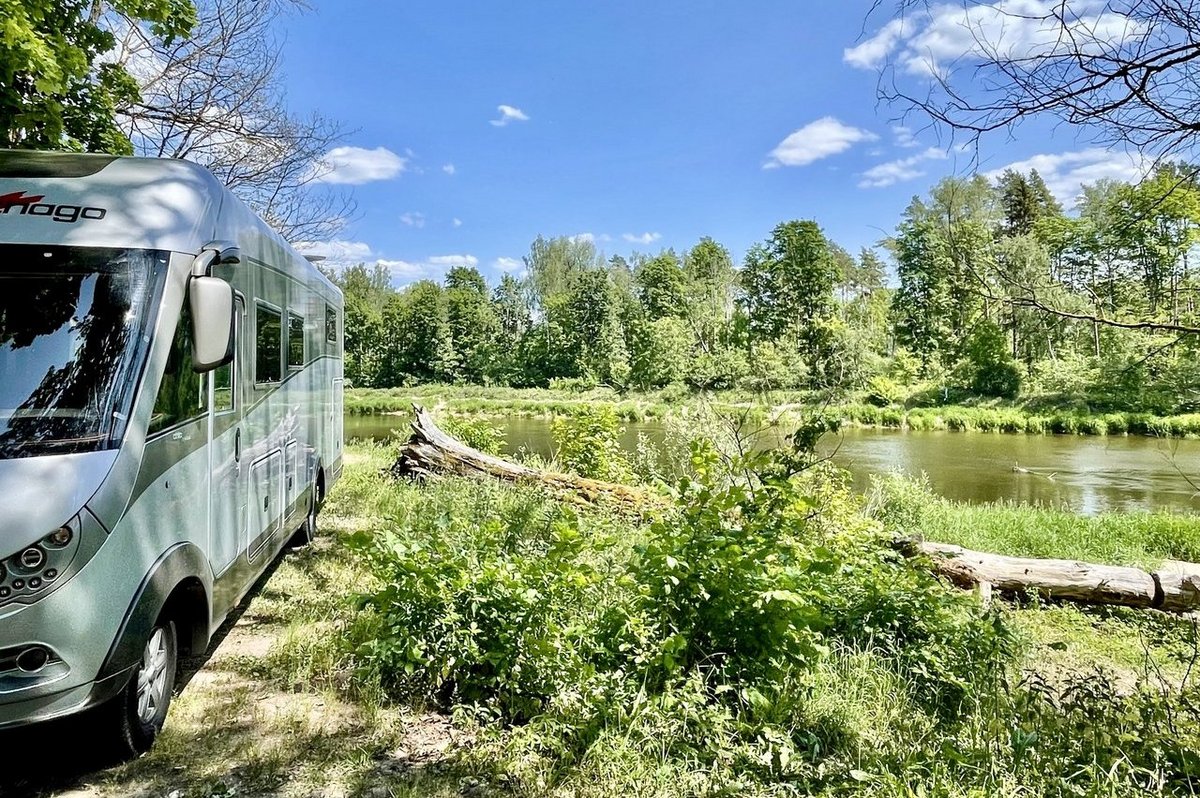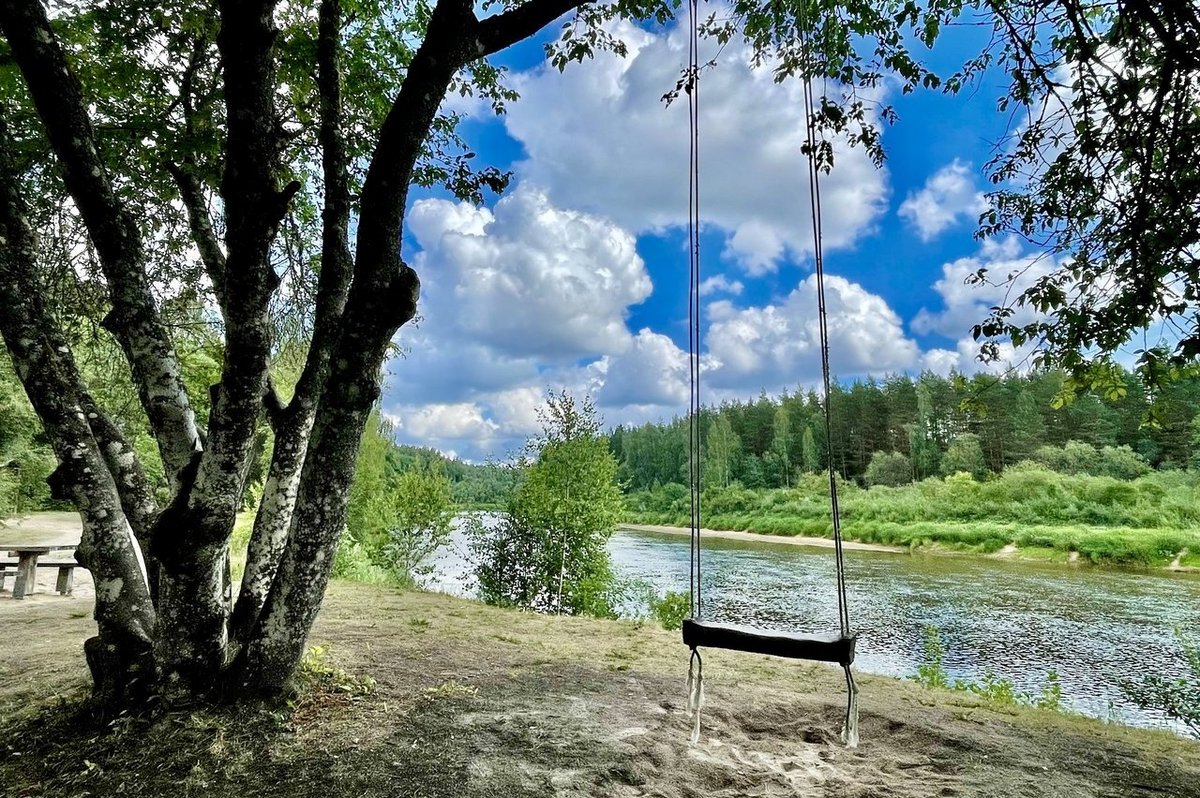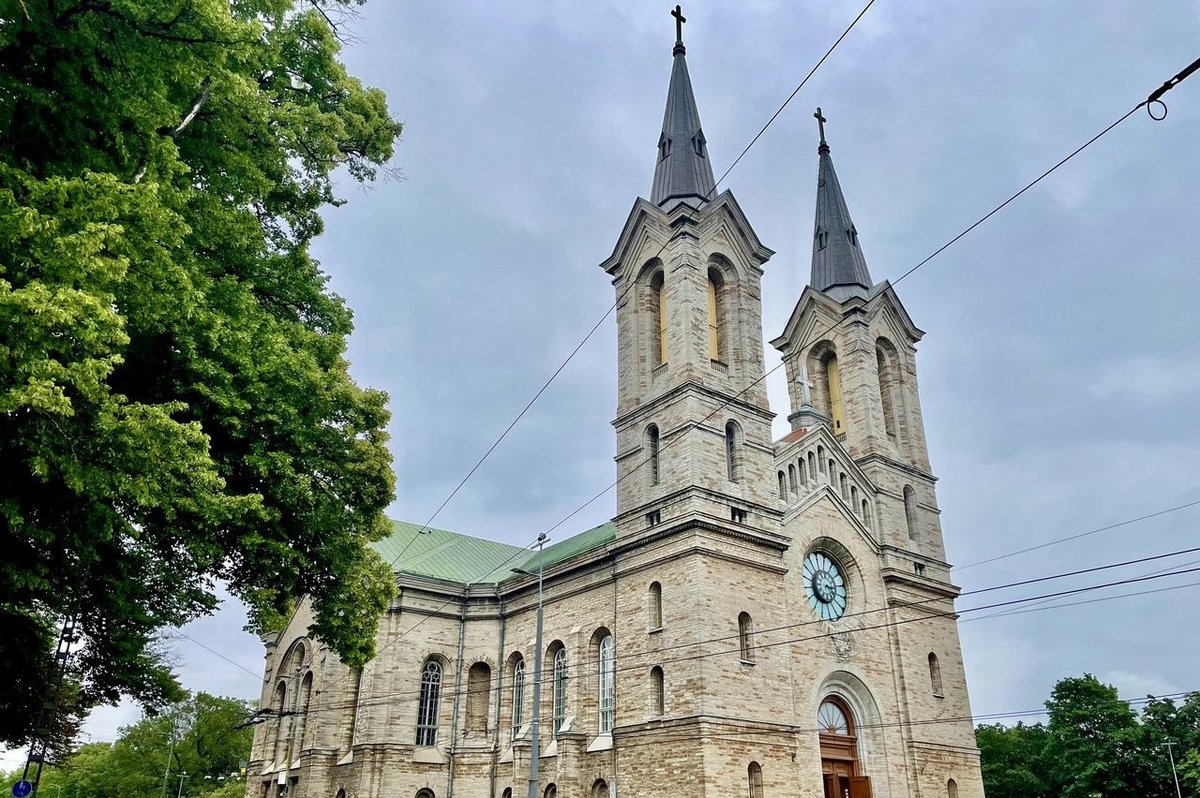TWO CARTHAGO MOTORHOMES IN THE BALTICS
Our customers Lena and Sven were travelling in the Baltic States with their chic s-plus. And they weren't travelling alone.
Find out who they met and what they experienced in this travelogue.
This trip was actually on the agenda back in 2019, until we decided to travel through Great Britain and Ireland due to the impending Brexit.
Due to the current political situation, we were often looked at askance when we told people about our plans, but we felt that these concerns were unfounded. After all, now of all times, the locals are happy about every tourist who is interested in their culture and nature.
Ronny and Yvonne, also Carthago owners who love travelling and whom we had met via our Facebook group "Carthago Fanclub", thought the same. When they heard about our plans, they spontaneously cancelled their own plans to join us on this trip.
In early June 2023, two Carthagos set off for north-east Europe to explore Lithuania, Latvia and Estonia over the course of 3.5 weeks, stopping off in Poland on the outward and return journeys.
The route
We started in Munich.
After an overnight stop near Dresden, we travelled in 2 stages to Masuria in Poland. From there, with a detour via the border triangle of Poland - Lithuania - Kaliningrad into the Baltic States. We travelled inland to the Bay of Riga and from there further west towards the north, with a detour to the Estonian island of Saaremaa.
The return journey was initially further east and then back across the interior to Masuria and finally to Germany.
First of all, drive down...
As we discovered on site, the whole of Poland had a public holiday with a subsequent bridge day, which is why we had to postpone our planned canoe tour on the popular Krutynia River to the return journey at short notice.
Instead, we made ourselves comfortable away from the crowds of tourists on a pitch by Lake Deyguhn and waited for our friends Ronny and Yvonne, who were to follow the next day.
We enjoyed the peace and quiet after the long journey and were already looking forward to the coming weeks together.
.
Right up to the Russian border
Anyone travelling to Lithuania via Poland cannot avoid driving past the Russian border of Kaliningrad. So it makes sense to take a detour to the border triangle of Poland, Lithuania and Kaliningrad.
There is something bizarre and strange about standing in the middle of free Europe and looking at a NATO barbed wire with a Russian province behind it. One can only hope that this border will never have to be actively defended.

Ruins, castles and a sea of crosses
Lithuania showed its charm and culture right from the start. While driving, Yvonne did a Google search and found a lost place, of which there would be a few more on our journey: an old ruin that had been left behind and was falling apart. Of course, we didn't hesitate for long!
This mysterious and fascinating site tells of times long past and was perfect for a few spectacular drone shots, in which we were also able to showcase our Carthagos beautifully.
After the tour, we continued on to our first actual stop: the Šiauliai Hill of Crosses. Here, on a hill around 10 metres high, there are countless crosses in all shapes and sizes. There are many myths about the original origins of this place of pilgrimage. The fact is, however, that the Russian regime tried to destroy this place several times in the past. However, the locals and believers from all over the world did not give up and erected their crosses again and again.
To round off the day, we travelled on to Rundāle Castle. Due to the late arrival time, we had to reduce our visit to the ornate castle gardens. However, it was also well worth seeing, varied and so large that we were unfortunately unable to discover everything before closing time. Instead, we were able to enjoy the view of the baroque palace for the rest of the evening, as our overnight accommodation was located directly in front of the estate.
The ancient Hanseatic city of Riga
We have already left Lithuania, but should be able to enjoy the country again on our return journey.
Instead, Riga, the capital of Latvia and the so-called "Pearl of the Baltics", was on the agenda today. The city was a harmonious blend of medieval architecture and modern elegance against the backdrop of the breathtaking Baltic Sea.
As soon as the motorhome was parked on a pitch on the harbour of the River Düna opposite the old town, we immersed ourselves in the local culture. We strolled through the narrow cobbled streets of the old town and marvelled at the intricate facades of centuries-old buildings.
The day was crowned by a meal in the rustic Pētergailis restaurant, which was founded back in 1978 and is located in a building dating back to the early 18th century.


The Gauja National Park
We continued through picturesque landscapes and small villages into the Gauja National Park, which is known for its lush nature, dense forests and the river of the same name, the Gauja. And we wanted to explore the latter with our inflatable boats.
Ideally, we found a pitch right on the banks of the River Gauja near the town of Sigulda. From here, we organised a driver to take us to the planned starting point just under 20 kilometres upstream.
During the tour, we enjoyed the peace and solitude. Not a soul was to be seen or heard for miles around. The river was lined with trees, caves and impressive rock formations and here, too, we launched our drone to take spectacular aerial shots of the scenery.
Back at the pitch, we enjoyed the evening on the riverbank with wine and a campfire.



Soomaa National Park
The next national park was already waiting for us: Soomaa National Park. To get there, however, we first had to negotiate a 15-kilometre gravel road. Our Carthagos got quite dusty, but mastered the journey with flying colours.
Soomaa National Park is located in the centre of Estonia and consists of extensive moorlands. These wetlands are particularly known for their seasonal flooding, which occurs in spring when the snow melts and the rivers swell. This event is also known as the "fifth season".
However, there was no sign of this in June. Unfortunately, Estonia had been plagued by persistent drought in the previous weeks, which is why the moors had completely dried out.
Nevertheless, we explored the area on the Ingatsi Trail, a 4.3-kilometre circular hiking trail on wooden footbridges, which leads through the middle of the moorland and also offers a viewing tower for a panoramic view.
But hiking wasn't enough for us! Paddling was simply part of a national park. So the next day we got our boats out again after the friendly campsite operator from Watercamp Estonia took us to a launching point 5 kilometres upstream.
In contrast to the River Gauja, the River Navesti was wider, but still no less spectacular. We passed under fallen trees and through reed forests, accompanied by numerous shimmering blue dragonflies.
Kuressaare, the historic capital of the island of Saaremaa
We also wanted to continue with the motorhome over Water. In Virtsu in the north-west, we took a 30-minute ferry across to the Estonian island of Saaremaa in the Baltic Sea. And even though the journey was short, there was an impressive selection of delicious food here, including the best solyanka we could find on the entire trip.
Our destination on the island was the island's capital: Kuressaare, also known as Arensburg. The town not only has a charming old town centre that invites you to take a leisurely stroll, but also a medieval castle with a defensive fortress, which was only a short distance from where we were sleeping. The thick stone walls, watchtowers and mysterious dungeons transported us back to a bygone era.
The next day we made a detour to the southern tip of the island to the Sõrve lighthouse, which we climbed via a spiral staircase.
Tallinn: History meets progress
From here, we went our separate ways for a while. While Yvonne and Ronny wanted to spend a little more time on the island and avoid the hustle and bustle of a capital city, we made our way back to the mainland and to Tallinn, the capital of Estonia.
Nowhere else in the world could the contrast be greater: On the one hand, you move through narrow cobbled streets, past Gothic churches, imposing city walls and medieval towers, while on the other, you come across autonomous DHL vehicles and delivery robots at various intersections, which autonomously make their way to their destination.
Tallinn combines both history and modernity, offers a unique blend of medieval charm, cultural wealth and technological progress and is a UNESCO World Heritage Site for good reason.
Cultural treasures of Estonia
We use the next day to immerse ourselves further in Estonian culture.
Firstly, we visited the historic Kolga Manor, which has had several owners and purposes over the centuries. It has not only been the seat of several noble families, but has also been used as a school and cultural centre. It now serves as a museum, but is also being completely restored by its current private owner.
Despite the fact that the museum was officially closed on a public holiday, we were lucky enough to meet the museum caretaker, who gave us a private tour of the rooms for a small fee.
Not far from the manor house was Palmse Castle. Unfortunately, this was also closed, but you could walk freely around the grounds, which included an English-style park, a café, several farm buildings and stables.
At the end of the day, we drove to one of the northernmost tips of Estonia in Lahemaa National Park and parked our Carthago right on the beach. From there, we were able to experience a beautiful sunset over the sea, just like the days before.
Tartu: University and cultural capital
Unfortunately, we were already heading south again. We made a brief stopover in Tartu, Estonia's second largest city, which is also a university city and the European Capital of Culture in 2024.
You can see the influence of the university here at first glance, as the city is young and lively, but at the same time offers many ancient cultural sites. We visited the old walls and remains of the cathedral, whose history dates back to the 13th century.
Unfortunately, we didn't have much more time for this lively city, as we had arranged to meet up with Ronny and Yvonne again further south.

Cliffs and gorges
We were reunited at a small campsite on the River Ahja. Of course, the plan was to unpack our boats again, but unfortunately the weather forecast threw a spanner in the works.
Instead, we took our e-bikes out of the Rear garage and drove 5 kilometres to the starting point of a short hike through the Suur Taevaskoda nature reserve. The area is known for its breathtaking sandstone cliffs and gorges.
Along the cliffs and through forests, the hiking trail led to several viewpoints from which you could see the sandstone cliffs and the river.
As the weather was still stable, we also took part in a river trip on the Riverboat Lonny. This allowed us to see more cliffs and caves from the Water.
We made it back to our motorhomes just in time before the rain.
A Lenin in the forest
We crossed the border to Latvia again with our next destination: to visit Lenin. Yes, that sounds crazy, but it's true! In the middle of nowhere in a wooded area, on a concrete surface, stands a Lenin head some 3.5 metres high, which towered over even our Carthago chic s-plus.
However, it wasn't just any place, but a former launch base for nuclear missiles. The head stood directly on the missile launch pad. Several signs and photos provided further information about the history of this place, a time that is fortunately in the past and will hopefully remain so.


What doesn't fit is made to fit
We were heading back to the Gauja National Park, because there was still a lot to see here! First of all, however, we needed a new place to spend the night. We chose a pitch, which this time was on the other side of the river.
The way there was going to be adventurous. The last 700 metres led through a forest path lined with trees, some with low-hanging branches that protruded into the road. But we weren't going to let that get us down.
Necessity is the mother of invention, so we fetched our telescopic washing brush from the Rear garage, which we always carried with us (after all, a 3.2 metre high chic s-plus needs to be cared for from top to bottom). With this, we were able to push the low-hanging branches high enough to drive under them.
Side branches were pushed away by the co-drivers with combined strength and where even that didn't help, branch shears and mini-saws were used. We are always fully equipped for any situation.
And it was worth the effort! We found a secluded and idyllic spot right by the river with picnic tables and even a swing.
A bunker that is no longer quite so secret
The next day we travelled on to Līgatne to the so-called Secret Soviet Bunker. Of course, it is no longer that secret. Nevertheless, the rehabilitation centre still stands on the site today, which then as now had direct access to the bunker in the basement, which none of the employees or residents knew about at the time. It seemed very bizarre to enter a rehabilitation centre in order to start a guided bunker tour from there.
It was a civil defence bunker from the Cold War era, which was active for more than a decade but was (fortunately) never used. During the tour, we were guided through several rooms and learnt fascinating details about the time and the purpose of each room. Much of it would still be usable today, as the rooms were still in their original condition.
All in all, an exciting and vivid journey into the past!
The moated castle of Trakai
This was the last time we would go our separate ways - or was it? As we wanted to make a detour to the east of Lithuania, we had to say goodbye to Ronny and Yvonne again, as they were already travelling on to Poland. At the time, we thought it would be the last farewell, but things turned out differently.
First of all, however, we made our way towards Vilnius to what is probably Lithuania's most famous sight: Trakai Castle.
It stands imposingly on a small island in the middle of a group of islands on Lake Galvė, connected to the mainland by a bridge. The 14th century castle is also home to the National Historical Museum, which offers insights into the history of the region, Lithuanian culture and the history of the castle itself.


Goodbye, Baltic States!
Unfortunately, everything comes to an end, including our trip through the Baltic States. It was an impressive and historic experience, with a perfect blend of culture and nature. Fortunately, you don't notice anything of the current war in Ukraine here, only the past wars still offer many contemporary witnesses.
We can only recommend everyone to visit these three very different countries. They have something to offer for every taste and the locals, who have always been very welcoming, are always happy to meet us!
A reunion
The big advantage of a motorhome?
As the name suggests, you are mobile and can be spontaneous! That's what happened to Ronny and Yvonne. When we made our last holiday stop in Masuria to catch up on the canoe trip on the Krutynia River that we had cancelled at the beginning, the two of them decided to come here after all. They had just finished their planned visit to the Wolf's Lair not far from us when they made their way straight to our campsite and arrived less than an hour later. Needless to say, they were delighted!
We opted for a canoe tour of around 8 kilometres, which the campsite operator kindly drove us to the starting point in Ukta. The Krutynia is an extremely picturesque and crystal-clear river and the peace and quiet we found this time made the tour a wonderful and relaxing experience.
We were able to enjoy our (now really) last holiday evening together in an idyllic setting around the campfire with a view of the river and review the trip, which was full of many unforgettable experiences and impressions.
























